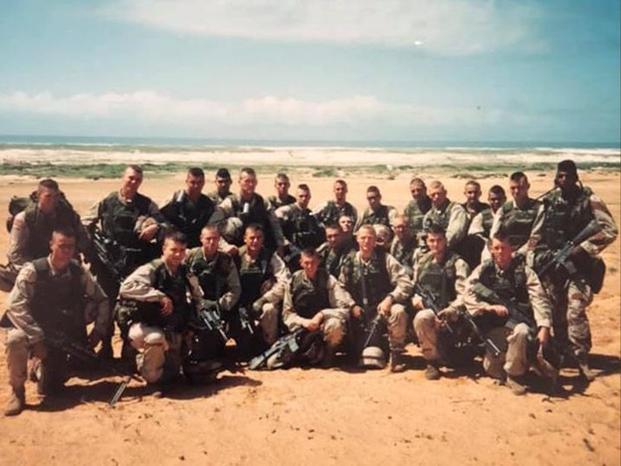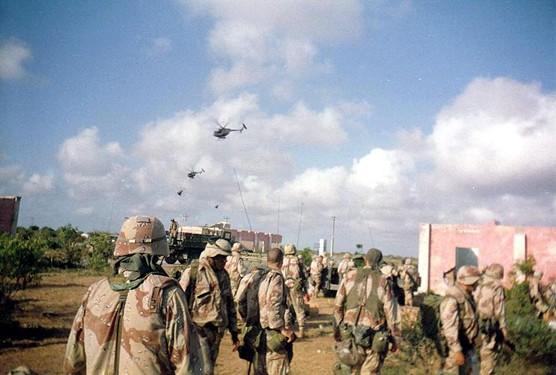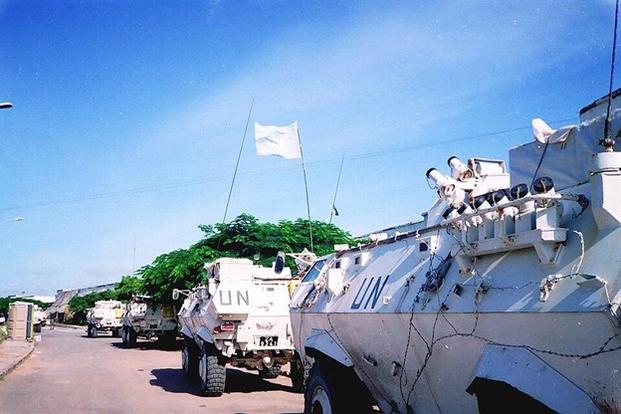On Oct. 3, 1993—32 years ago—what began as a short raid by Task Force Ranger in Mogadishu became an all-night fight for survival after two Black Hawks were shot down. As U.S. soldiers dug in around the crash sites, the rescue that finally broke through was a combined UN column built around Malaysian armored vehicles and Pakistani tanks, with two companies from the Army’s 10th Mountain Division riding shotgun.
Although the raid managed to disrupt a meeting near the Olympic Hotel between many of warlord Mohammed Farrah Aidid’s commanders, things went horribly wrong soon after. The mission quickly descended into chaos after an RPG downed a UH-60 Blackhawk and several Rangers were killed in the convoys while attempting to exfiltrate the city.
As Rangers and Delta operators pivoted to secure the first crash, another Black Hawk fell two miles away, splitting U.S. forces and forcing a hasty perimeter under constant RPG and small-arms fire. Attempts to reach them with unarmored Humvees were bloodily repulsed. Armored vehicles—absent from the U.S. mission—had to come from UN contingents in the city.

However, because of the raid’s secrecy, the UN forces were unprepared to launch an immediate rescue. UN forces scrambled and scrounged whatever was at hand, but it took the entire rest of the day before they were ready.
By late evening, American and UN commanders had assembled a relief column of nearly 100 vehicles: twenty-four Malaysian Condor APCs, four Pakistani M48 tanks, plus U.S. Humvees and trucks—a force stretching almost two miles. It stepped off around 11:24 p.m., with the armor up front. 10th Mountain soldiers boarded the APCs and were interspersed throughout the convoy to provide support to the UN troops.
Pakistani Brig. Gen. Ikram ul-Hasan, whose armored battalion was called into the rescue, said of his troops: “We will act boldly, aggressively, and firmly.”
The push in was ugly and hard-fought. In the maze of kill zones and corridors around National Street and the Olympic Hotel, two lead Malaysian APCs carrying U.S. troops were struck by RPGs and heavy machine-gun fire and veered off; one Condor was destroyed, and Malaysian Lance Cpl. Mat Aznan Awang—driving another Condor—was killed. Several more Malaysian APCs were knocked out or badly damaged. Pakistani tanks fired point-blank to clear roadblocks, while Malaysian and American troops dismounted to secure intersections and buildings under RPG and machine-gun fire.
By first light, the rescue force had reached both crash sites, loaded the wounded and dead, and began the exfiltration. Official U.S. reports recorded 18 Americans killed and 84 wounded in the battle; one Malaysian KIA, 10 Malaysian WIA, and two Pakistani WIA in the rescue; and an estimated 300–500 Somalis killed with more than 700 wounded.

“When we linked up with those guys, they were almost out of ammo, had no water, their mission planning was for a short duration and they had been stuck there for 16 hours,” said retired Staff Sgt. Ian Morrison, a former squad leader in the 10th Mountain. “If we hadn’t been there, they wouldn’t have made it out.”
The tail of the convoy and a group of U.S. soldiers who returned to base on foot—in what became known as the “Mogadishu Mile”—fought their way to safety at the Pakistani-held stadium as dawn broke on Oct. 4. Veterans later recalled language and coordination issues inside the column, burned-out vehicles in the streets, tanks halted by barricades that infantry had to clear under fire, and the sheer volume of RPGs and automatic fire hammering the formation. But the armor kept moving and got them out of the city.
The senior U.S. commander in Somalia at the time, Maj. Gen. Thomas M. Montgomery, later, tried to set the record straight about who made that breakout possible: “I’m very proud of the Malaysian and the Pakistani soldiers that were a part of [the mission], and I am enormously proud of the 10th Mountain Division, who got very little recognition.”

Those acknowledgements were reiterated publicly years later. In 2013, on the operation’s 20th anniversary, U.S. officials formally thanked Malaysian peacekeepers for their role and sacrifice at Bakara Market—recognition many Malaysians felt had been downplayed in popular retellings years later. Though their role was minimized in the popular 2001 film, Black Hawk Down, the UN forces were vital to the successful rescue of the American troops.
Despite not gaining the recognition they deserved, the UN armor from Malaysia and Pakistan—manned by troops who took their own casualties—joined with the 10th Mountain to punch through, evacuate survivors, and bring them home. That overlooked reality was a major reason the Americans were able to escape from the city at all, and it’s worth remembering alongside the fallen every Oct. 3–4.
















